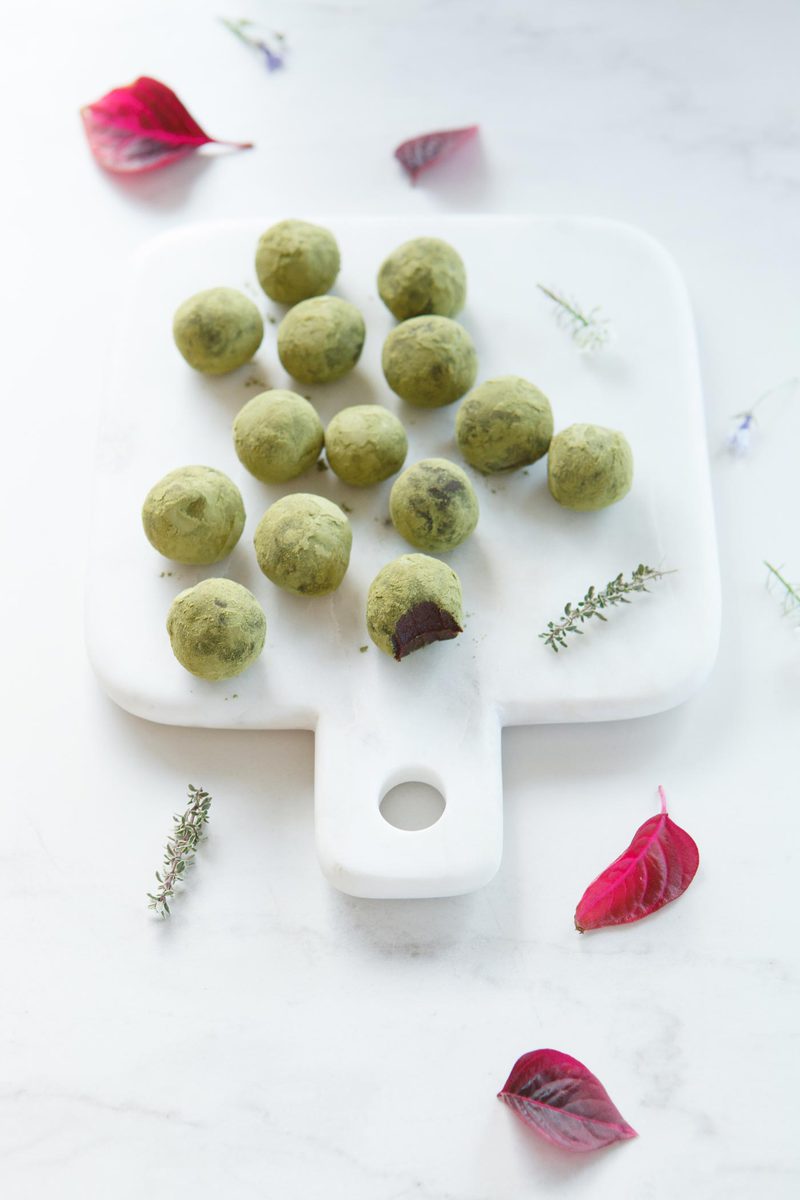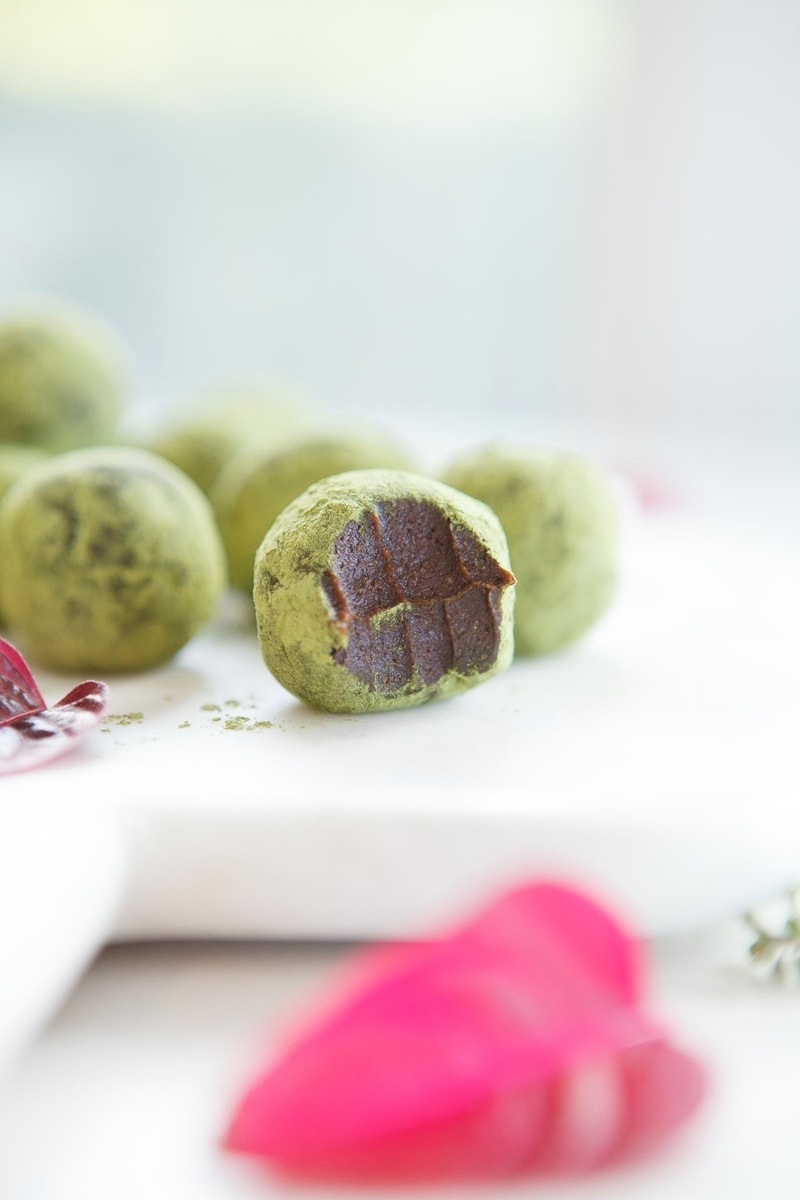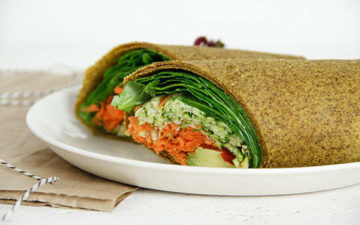
I guess these raw truffles are just an excuse to talk a bit about matcha, a type of green tea that I adore for its many benefits. The truffles themselves are super easy to prepare and extremely decadent, they only use 6 ingredients in total and are whipped up in no time at all.
We all know green tea is good for us – but Matcha in a way is supercharged green tea. With next level antioxidants! But first, a little about the different varieties of tea.
The difference between black, oolong, white and green teas
Interestingly, all of the above teas are all derived from the same plant, Camellia sinensis. The difference between them is simply in the way they are manufactured. The manufacturing process is also responsible for their differing amounts of polyphenols – the compounds in the leaves that provide their varied therapeutic activity by acting as antioxidants.
In making black tea, the leaves of the plant are picked, withered and oxidised, hence the darker colour (oxidised is another name for fermented in this context). During this process however, many of the polyphenolic compounds are enzymatically converted into compounds with far less therapeutic activity. From here, they are rolled, dried and fired. Of all the varieties, black tea has the highest caffeine concentration [1, 2].
Next we have oolong – a traditional Chinese tea (it translates as Black Dragon). After being picked and withered, then lightly bruised, they are left to partially oxidise/ferment, then are rolled, dried and fired. The firing process is unique to oolong teas, this roasting process is what lends a lovely smokey flavour. Oolong has slightly less caffeine than black.

White and green teas are even less processed and contain less caffeine again, than black and oolong, with a slightly sweet taste. White teas are made from the young leaves and the new growth buds of the plant. The leaves are picked and withered in the sun, setting the scene for a light fermentation that allows them to retain high levels of polyphenols.
Green tea is somewhere in the middle – the leaves are harvested a bit later than white and a bit earlier than the black. They aren’t withered, bruised or oxidised, but are heat treated, which denatures the enzymes responsible for oxidisation (so they are unfermented) and the loss of active therapeutic compounds. The heat treatment is known as ‘kill-green’ – it stops the natural fermentation process without damaging the leaves. After this process is complete, they are rolled into shape and dried.
What is Matcha?
Matcha is simply the whole, dried green tea leaf, ground into a fine powder. It is still from the same plant as those above - Camellia sinensis. The bright green powder that is matcha is served whisked into hot water. It is used in traditional Japanese tea ceremonies, has a light, sweet, but sometimes bitter taste, and seems to work well in desserts. Hello truffles!
Because the whole ground tea leaf is used, the nutritional value is far more potent – it makes sense when you consider that in regular green tea, you discard the leaves once you’ve steeped them in hot water. For example, matcha can contain over 100 times the antioxidants of regular green tea [3].
The antioxidant star we are talking about is epigallocatechin gallate (EGCG) – considered the most significant active compound in tea [1]. Antioxidants protect against free radical damage and help reduce inflammation.
[bctt tweet="Try these Raw Truffles dusted in the antioxidant rich Matcha, a bright green tea powder."]
The catechins in green tea (and matcha, as it is the same plant), have been suggested to have antiobesity effects. One study found tea catechins were able to promote weight loss in association with exercise [4]. Green tea has also shown to be beneficial in oral hygiene. When used as a mouth wash, it has demonstrated antibacterial activity and a decrease in oral pathogens [5]. A natural Listerine perhaps?!
There is also increasing evidence to suggest green tea is beneficial for cardiovascular disease prevention [1]. A recent review of studies found green tea consumption to have favourable effects, significantly reducing LDL-cholesterol and blood pressure, though more longer-term trials are needed to confirm findings [6]. Additionally, research suggests green tea consumption may offer protection against a range of different cancers [1].
Factoid: the Camellia sinensis plant contains tannins which can bind to iron and reduce its absorption – so if you’re taking iron supplements – take them a few hours apart from your cuppa tea [2].
How delightful.
Next on my list of matcha recipes to create is a home made matcha latte – because – well – how cool are they? Those iridescent green and cream swirls?
Enjoy the truffles,
Lx
📖Recipe

Raw Matcha Truffles
Ingredients
- 150 g Medjool dates pitted (about 9)
- ¼ cup + 1 tablespoon cacao powder
- ¼ cup homemade almond butter*
- 2 teaspoons vanilla paste or extract
- Small pinch of coarse sea salt
- 2 teaspoons matcha green tea powder, to coat
*To make your own almond butter, put four cups activated almonds in a food processor and blend till soft (this may take around 20 minutes), you may need to stop and add a tiny bit of coconut oil – but try and do this late in the process as the nuts release their oils naturally the more they are processed. Salt to taste. Store bought almond butter is not raw, it has been roasted, salted heavily, and has a much stronger flavour.
Ps. There’s a step by step guide to activating nuts on my Raw Desserts App.
Instructions
- Place all ingredients except the matcha powder in a food processor, and whizz till a sticky dough forms.
- Transfer the mixture into a bowl and pop in the fridge for 15 to 20 minutes – it will be near impossible to scoop and rolls the truffles if not – it needs to firm up a little first.
- Once cooled and a little firmer, scoop 1 teaspoon of mixture out and roll into a ball, then coat in the matcha powder. Repeat till finished – this mixture should make about 14 truffles.
- No need to store in the fridge – the matcha coating will also prevent them from sticking now.
Nutrition
If you make and enjoy this recipe, please leave a rating!

I'd love you to follow me on Instagram,
tag me @ascensionkitchen so I can see your creations!
References:
-
Murray, M.T. (2013). Camellia sinensis (green tea). In J.E. Pizzorno & M.T. Murray (Eds). Textbook of Natural Medicine (4th ed. pp. 627-632). Missouri: Churchill Livingstone
-
Braun, L, & Cohen, M. (2015). Herbs & natural supplements. An evidence-based guide (4th ed., Vol. 2). Sydney, Australia: Churchill Livingstone
-
Weiss, D.J., & Anderton, C.R. (2003). Determination of catechins in matcha green tea by micellar electrokinetic chromatography. Journal of Chromatography, 1011 (1-2), 173-180. doi:10.1016/S0021-9673(03)01133-6
-
Maki, K.C., Reeves, M.S., Farmer, M., Yasunaga, K., Matsuo, N., Katsuragi, Y., … & Cartwright, Y. (2009). Green tea catechin consumption enhances exercise-induced abdominal fat loss in overweight and obese adults. The Journal of Nutrition, 139 (2), 264-270. doi: 10.3945/jn.108.098293
-
Ferrazzano, G.F., Roberto, L., Amato, I., Cantile, T., Sangianantoni, G., & Ingenito, A. (2011). Antimicrobial properties of green tea extract against cariogenic microflora: An in vivo study. Journal of Medicinal Food, 14(9), 907-911. doi:10.1089/jmf.2010.0196.
-
Hartley, L., Flowers, N., Holmes, J., Clarke, A., Stranges, S., Hooper, L., & Rees, K. (2013). Green and black tea for the primary prevention of cardiovascular disease. Cochrane Database of Systemic Reviews, 6. Art. No: CD009934. doi: 10.1002/14651858.CD009934.pub2.




Ask me anything